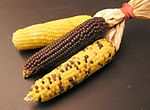Corncob

A corncob, also called cob of corn or corn on the cob, is the central core of an ear of corn (also known as maize). It is the part of the ear on which the kernels grow. The ear is also considered a "cob" or "pole" but it is not fully a "pole" until the ear is shucked, or removed from the plant material around the ear.
Young ears, also called baby corn, can be consumed raw, but as the plant matures the cob becomes tougher until only the kernels are edible.
When harvesting corn, the corncob may be collected as part of the ear (necessary for corn on the cob), or instead may be left as part of the corn stover in the field.
The innermost part of the cob is white and has a consistency similar to foam plastic.
Uses[]
Corncobs find use in the following applications:
- Industrial source of the chemical furfural[1]
- Fiber in fodder for ruminant livestock (despite low nutritional value)
Other applications include:
- Bedding for animals – cobs absorb moisture and provide a compliant surface[2]
- Ground up and washed (then re-dried) to make cat litter
- A mild abrasive for cleaning building surfaces, when coarsely ground
- Raw material for bowls of corncob pipes[3]
 A corncob pipe
A corncob pipe - As a biofuel[4]
- Charcoal production
- Environmentally-friendly rodenticide (powdered corn cob)
- Soil conditioner, water retainer in horticulture[5]
- Absorbent media for safe disposal of liquid and solid effluents[5]
- Diluent/carrier/filler material in Animal health products, Agro-chemicals, Veterinary formulations, Vitamin premixes, Pharmaceuticals, etc.[5]
- Xylose – a sweetener[6]
- Anal hygiene[7]
References[]
- ^ Engineers, N.B.C. (2006). Wheat, Rice, Corn, Oat, Barley and Sorghum Processing Handbook (Cereal Food Technology). Asia Pacific Business Press. p. 173. ISBN 978-81-7833-002-0.
- ^ Aston, Andrew (November 14, 2010). "Bedding For Laboratory Animals". ALN Magazine. Archived from the original on September 27, 2015. Retrieved October 28, 2015.
- ^ Tobacco Leaf. 1907. pp. 36, 38. Retrieved October 29, 2015.
- ^ Roth, Greg; Gustafson, Cole (January 31, 2014). "Corn Cobs for Biofuel Production". Cooperative Extension System. Retrieved October 28, 2015.
- ^ Jump up to: a b c "Corn Cob Powder". www.rahiindustries.com.
- ^ Hudson, C. S.; Harding, T. S. (1918). "THE PREPARATION OF XYLOSE FROM CORN COBS". Journal of the American Chemical Society. 40 (10): 1601–1602. doi:10.1021/ja02243a010. ISSN 0002-7863.
- ^ Ruane, Michael E. (18 Mar 2020). "Toilet paper takes center stage amid coronavirus outbreak. Be thankful we no longer use corn cobs and rope ends". The Washington Post. Retrieved 31 July 2021.
External links[]
- Maize
- Agriculture stubs


